|
Post Hostilities : 1946-48
While the Second World War was in progress, all Vincents production was
switched over to the manufacture of essential equipment to support the
war effort. However, while doing this, Phil Vincent and Phil Irving also
looked at re-designing their Series 'A' Twin, ready for when the hostilities
ended. The result of these efforts culminated in the first Series 'B'
Rapide going into production in 1946.
Designed to run on 72 octane 'Pool' quality petrol, all that was available
after the war, the Rapide was still capable of touring at speeds up to
100mph and an extremely impressive maximum of 110mph.
It was no suprise that before long the Rapide was being used by many customers
as a sporting machine, and was entered in many early post-war races, particularly
the Clubmans TT with numerous riders making excellant performances, including
J.Daniels who won the 1948 Clubmans TT and Ted Davis who was 5th.
|
|
J.Daniels - 1948 Clubmans
TT
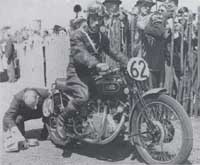
|
|
|
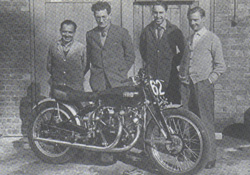
Early picture of Gunga Din, Brown brothers,
Phil Irving and Mike Eggington
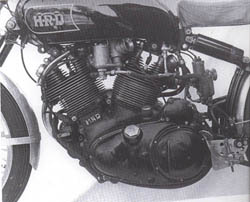 Drive Side View of Gunga Din (Note flange fitting TT Carburettors)
Drive Side View of Gunga Din (Note flange fitting TT Carburettors)
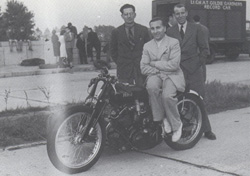
Rene Milhoux and Phil Irving, Belgium 1948
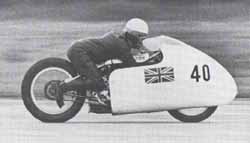
George Brown and Super Nero at Elvington.
@200mph!
|
|
The Forerunner of the Black Lightning
Among Phil Vincent's workforce after the war were two brothers, George
and Cliff Brown. ( George went on to become a legend for his campaigning
of two Vincent sprint bikes, Nero and Super Nero, two awesome sprinters,
with which he held numerous sprint records over a 20 year period.
See footnote). Anyway, in 1947 Cliff, George and Phil Irving had got
hold of a Rapide that had been rejected from the test department because
it was generally regarded to be a rattler, with poor performance to
boot.
Christened 'Gunga Din', they meticulously stripped and rebuilt this
bike in their spare time, until eventually it was ready to race. Over
the next two years this motorcycle was raced (mainly by George) at
many road races and sprints, it being so successful that at some races,
attempts were made to ban it to ensure someone else would stand a
chance of a win!
Amongst many other great successes, George took the bike to Shelsley
Walsh in 1948 and broke the course record with a run of 37.13 seconds,
which took many years to beat.
In September 1948 Gunga Din was taken to Belgian, where ridden by
Rene Milhoux it was used to break the Belgian National speed records
with a run of 143 mph. It was also able to set new sidecar speed records
in the standing start kilometre and standing start mile class of 80.49
and 91.95mph respectively.
It was due to the success of Gunga Din
that when Phil Vincent returned from America at the end of 1947,
he was so impressed that he saw the great potential of a sports
version of the Rapide, and it was from this that the immortal Black
Shadow was born.
The Black Shadow went into production in early 1948 and with a slightly
higher tune of engine than the Rapide, was timed at 122mph on 72
octane petrol. Major changes were concentrated around the engine/gearbox
where a 7.3-1 compression ratio was used, slightly larger 1.125s
carburetors and what would these days be termed 'Blueprinting' of
most mechanical components.
Add to this the slightly better finned brakes, a beautifully striking
black finish (as opposed to polished alloy) and of course that wonderful
5 inch Smiths speedometer and it is no surprise that eventually
the Black Shadow eventually went on to outsell the Rapide.
* Footnote:
Unfortunately I was not old enough to see Super Nero being ran by
George in its hayday. However, many years later when sprinting my
own Norton, I was fortunate enough to watch Tony Brown (George's
son) running both bikes in 'demo' runs, the site of which was amazing,
particularly the supercharged bike, Super Nero.
On one occasion I helped hold down the rear wheel of Super Nero
on its starting rollers, powered by their transit van, (which were
used to turn the big supercharged engine over, it being impossible
to bump start). Unfortunately I had not fitted ear plugs beforehand,
so when the engine finally roared into life, the resulting ear splitting
bellow left me deaf for almost 10 minutes! Having heard hundreds
of exotic racing engines I can confirm that that engine is still
the most deafening and glorious noise I have ever heard!
|
|
|
|
|
|
|
The First Black Lightning
The first real Black Lightning came about as a result of a
trip to California by Phil Vincent in 1948, where he was introduced
to a wealthy journalist with an interest in fast motorcycles
by the name of John Edgar. It transpired that John Edgar had
an ambition to own a motorcycle holding the American speed
record and Vincent Martin, the local Vincent dealer pointed
out that the current Black Shadow was already capable of 120+mph
speeds, so John realised it might not take much tuning to
make his ambition a reality.
Phil Vincent realising that Gunga Din had already been tuned
to a much higher state of tune than a standard Black Shadow,
offered to provide John Edgar with a machine capable of attaining
the record, if John was prepared to pay an additional £50
over the cost of a standard Black Shadow.
So it was that Phil Vincent wrote to Phil Irving giving details
of the bike he wished Irving to prepare in readiness for the
record attempt. Phil Irving spent some considerable time preparing
special cams for this motorcycle, which later became known
as the famous MKII cams. Equuiped with these cams and running
on Methanol, George Brown was able to test the bike up to
143mph before having to shut off due to lack of road.
This machine, known as the Black Lightning was sent to America
for Rollie Free to ride on John Edgars behalf, it being received
on August 27th 1948.
Having removed a number of items such as lighting gear, front
brakes and such, the machine was ran on September 13th and
having made two runs Rollie was successful in taking the record
at an average speed of 148mph.
However Rollie himself was keen to crack the 150mph barrier
that Phil Vincent had promised the machine was capable of,
so stripped down to just his bathing trunks (his leathers
had been torn in the previous attempt) he tried again. This
time he was successful, becoming the first person in America
to crack the 150mph barrier, with an average speed of 150.313
mph!
Rollie later went back with his own Black Lightning, it being
fitted with a fully streamlining shell. Unfortunately it seems
that the enclosure's aerodynamics were not particularly good,
which resulted in Rollie losing control of the machine at
high speed and him and the bike sliding end over end for a
1000 feet before coming to a stop. Amazingly, Rollie was able
to walk away from this crash with little more than salt burns.
That was not the end though, the shell was removed and in
1953 Rollie was eventually to manage an average two way run
of 160.73 mph and a fastest one way time of 163.54 mph. He
never achieved his ambition to better 180mph though, which
with the correct aerodynamic shell fitted he felt the bike
was capable of.
|
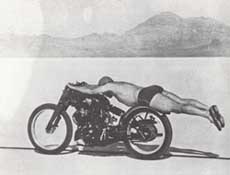
Rollie Free and Black Lightning at
Bonneville 1948
|
|
|
|
|
|
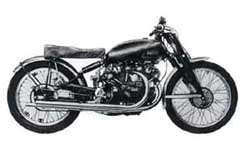
First Production Lightning 1948
|
|
|
|
|
|
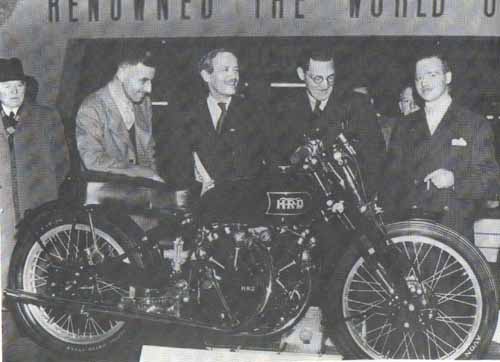
1949 Earls Court Show
|
|
|
|
|
|
|
|
|
|
|
|
|
|
|
|
|
Production Black Lightning's
As far as I can tell there never really was a standard production
Black Lightning as such! According to Phil Vincents own recollections
in Roy Harper's well known book The Vincent H.R.D. Story,
only 20 or so Vincent Black Lightning's were produced in all,
from John Edgars first bike in 1948, to the last one produced
in 1955. However, later accounts put the figure closer to
33 bikes, not including the likes of Gunga Din. If you visit
the excellent web site thevincent.com you will see that they
have put together a very comprehensive list of the complete
machines, including engine chassis numbers and first owners.
In Dennis Minnet's notebook (an excellent journal from a
the man who was in charge of the Special Engine Department),
the first 'shakedown' engine is shown as being worked on in
February 1949, with the first actual reference to a Lightning
being engine number 1803 in March 1949. The last production
Black Lightning seems to have been engine number 9818, which
according to the list compiled by , was purchased in 1956.
It seems difficult to define exactly what the 'standard'
Black Lightning specification consisted of, as supposedly
each one was subtly different. That said, although not conclusive,
I have listed below the generally accepted major changes that
made the Black Lightning different from road going Vincent
twins.
|
|
|
|
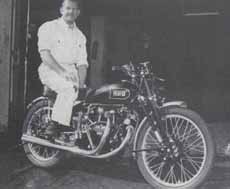
Vic Proctors Black Lightning (1949?)
|
|
|
|
|
|
|
|
|
|
|
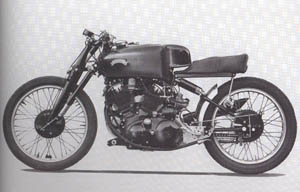
Vincent Badged Lightning
(Note sidecar engine plates and large tank)
|
|
|
|
|
|
|
|
|
|
|
|
Engine/Gearbox
· Stronger 'Vibrac' connecting rods
· High compression pistons (different ratios dependant
on fuels used)
· Caged roller big end, in place of road going crowded
roller version. (I know that some alloy pinned big ends were
fitted into Grey Flash's but I don't think these were tried
in twins).
· MKII cam profiles
· Steel idler timing gears
· Highly polished internals, including flywheels, conrods,
cam followers inner crankcases
· Bigger inlet ports (early bikes were fitted with
a front and rear heads but later bikes were fitted with two
rear heads as these were easier to bore to 32mm)
· Close ratio gear cluster, with some gears being double
backlashed for quicker changes
· Lightened gear selector plate and gearchange emechanism
· Lightened clutch drum and components. Solid Ferodo
primary clutch plate fitted. Clutch cover with centre opening
(mine has additional cooling holes like many I have seen)
· Primary sprocket lightened? (seems to have been done
on some bikes)
· Kickstart mechanism removed
· Twin start oil pump fitted (this does not seem to
have been done originally but is a very common modification
with racing twins in later years)
· Racing TT/GP carburettors. Early machines seem to
have been fitted with more standard stub fitting TT carburettors
(with associated racing inlet stubs), while later machines
were fitted with a special batch of clip fitting GP carburettors.
· Lucas KVFTT manual advance racing magneto
· 2 inch bore straight through exhaust pipes, normally
44" long and of thinner gauge than standard pipes. Narrower
exhaust nuts.
Wheels and Brakes
· Alloy wheel rims instead of steel
· Alloy brake plates with cooling scoops instead of
pressed steel plates
· Ribbed brake drums
· Brake cams drilled through the lobe for lightness
· Brake securing arm on rear brakes drilled for lightness
· Different axles without tommy bars (I have fitted
tommy bar axles as I just like them better!)
· ¼" inch rear sprockets and chain instead
of 5/16" inch.
Chassis/Cycle Part Differences
· Forks - It seems these were identical to road going
twins. Grey Flash's were fitted with the main blades lightened
on their inner faces but I don't believe any twins had this
modification originally (presumably as most were intended
for sidecars where greater strength was necessary)
· Petrol Tank with different cutaway for racing carburettors
(and racing fuel taps)
· Drilled rear swinging arm mounting plate (not sure
if this was carried out on all Lightning's)
· Rearset gearchange and brake mechanisms, fitted on
alloy plates.
· Normal 'bolt' chain adjusters, instead of Vincent
alloy knobs
· Competition mudguards and stays
· Shortened chainguard
· Competition Feridax seat (I have seen quite a few
different varieties of these, the earlier ones always seem
slightly thicker and in some photographs, more brownish in
colour)
· 3.5 inch Smiths 0-8000 rev clock with yellow numerals
(as far as I am aware, this type of rev clock was only ever
fitted to Black Lightnings's and is certainly one of rarest
parts to find, face is marked RC115)
· (Optional) 3.5 inch Smiths 180mph speedometer with
yellow numerals (I have only ever seen one photograph of these
and never one in the flesh - obviously I am looking for one!)
|
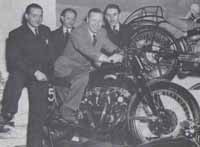
George Formby on Gunga Din at Kings
of Oxford (Note 'Big Port' heads fitted)
|
|
|
|
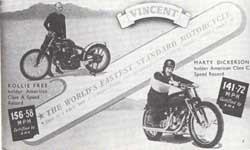
Contemporary Advert
|
|
|
|
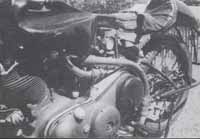
Reg Deardons Supercharged Lightning
|
|
|
|
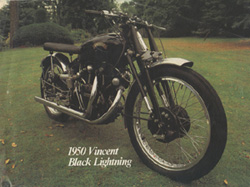
Restored 1950 Black Lightning
|
|
|
|
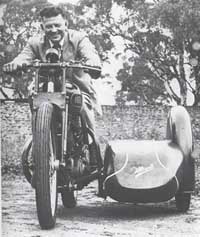
Les Wharton with his
record breaking Lightning
|
|
|
|
|
|
|
|
|














